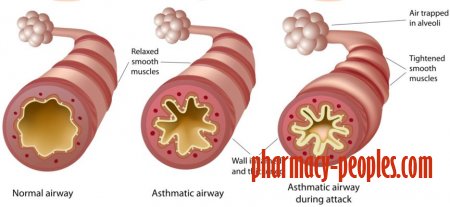WHAT IS ASTHMATIC BRONCHITIS?
Asthmatic bronchitis is a pathology of the bronchi an inflammatory nature, accompanied by shortness of breath, cough. It is a chronic form of the disease.
Asthmatic bronchitis is a disease of the upper respiratory with chronic and inflammatory in nature, allergic and/or infectious etiology. Bronchitis with asthmatic component is different from asthma that is not accompanied by suffocation.
The disease most often is diagnosed in children of preschool age and pupils of elementary schools, the history of which includes such diagnoses as atopic dermatitis, diathesis and allergic rhinitis.
In the course of the disease are 2 phases - the aggravation and remission. Stage 1 is invoked, as a rule, loads the physical plane, hypothermia, and viral infections. Not exclude the allergic nature of exacerbations. The disease may be accompanied by slight rise of temperature, symptoms of intoxication. Asthmatic bronchitis in the acute phase is manifested persistent cough that becomes more severe during the night. Shortness of breath accompanied by shortness of breath.
Remission - a period when the patient's state of health improves.
CAUSES OF PATHOLOGY
It should be remembered that the causes of such diseases as chronic bronchitis, quite numerous. That is why it is polietiologic disease, which is caused by 3 types of agents:
- Infectious arising from pathogenic Staphylococcus. Bronchitis is often a complication of diseases such as pneumonia, laryngitis, tracheitis, influenza, whooping cough.
- Non-communicable - allergens. It may be house dust, pollen of plants and flowers, pet hair, feathers trees, food. In case of chronic bronchitis with asthmatic component in children the disease is often a consequence of vaccination and/or drug Allergy.
- Hereditary.
The type of agent that caused the disease, determines not only the disease but also the frequency and seasonality of periods of exacerbation.
AS CONCEIVED AND DEVELOPED THE DISEASE?
The impetus for the development of the disease is a hypersensitivity reaction of the bronchial tubes to various allergens, especially if a weakened immune system or inflammation. Immune to the conflict along the lines of "allergen-antibody" is developing in the medium and/or large bronchioles. Smallthe bronchioles are not subjected to the inflammatory process. This explains the fact that the clinical picture of the disease does not have the brightest of bronchospasm. It is therefore incorrect to say that asthmatic bronchitis is asthma. This is predostatochno condition.
The type of immunopathological reactions will have 2 forms of the disease:
1. Atopic - Allergy reaction develops quickly. The mucosa is characterized by pallor, edema, segmental bronchi as a result of swelling narrowing in their lumen, a large amount of viscous mucous secretion.
2. Infectious-allergic. Mucosa is swollen, there is a Muco-purulent secret.
SYMPTOMATIC PICTURE
Asthmatic bronchitis has exacerbations and remission. In the acute phase in adult patients the disease has these symptoms:
- the attacks of coughing that occur after laughing, crying, physical exertion;
- sero-mucous rhinitis, nasal congestion is the forerunner of cough;
- a slight deterioration of General health;
- a slight rise in temperature;
- the sore throat.
At the peak of an exacerbation patients may experience:
- shortness of breath;
- shortness of breath;
- exhale with a rattle and a whistle;
- abundant expectoration of sputum.
In non-infectious form of the disease, the cessation of contact with the allergen cough can result. In children the symptoms of asthmatic bronchitis may be accompanied by other manifestations of allergic diseases.
DIAGNOSIS OF THE DISEASE
For the diagnosis of "bronchitis with asthmatic component," the patient must pass examinations by 3 specialists: allergist, pulmonologist and immunologist.
While listening to the expert notes hard breathing with moist rales wheezing type. Following required inspection - x-ray. When asthmatic bronchitis radiograph may show:
- the dilution of the lung pattern, its concentration;
- the gain pattern of the root of the lung.
Endoscopy is also mandatory for the correct diagnosis. Because of the variety of the painting, which can be obtained by experts are not based only on the results of endoscopy. During the examination the patient's blood revealed elevated levels of histamine, eosinophilia, increased immunoglobulin E and A.
If you suspect an allergic nature of the disease, the patient is assigned a skin test with the alleged allergen.
For infectious forms examines the sputum and determine the sensitivity toa variety of antibiotics.
METHODS OF TREATMENT OF PATHOLOGY
Treatment of bronchitis with asthmatic component is always complex and individual. In the acute phase of the pathology necessarily assigned expectorant drugs. If you have a fever - antipyretics. For removing the swelling recommended the holding of inhalation using a nebulizer. In allergic form are antihistamines.
The patient in the acute phase should stay in bed, try to drink as much as possible. If there is a accession of any infection of a microbial nature, is assigned to appropriate therapy.
When will the acute phase, patients undergoing immunotherapy. Conducted a study on the determination of the allergen that causes the attacks. Recommended breathing exercises, massage of the chest.



